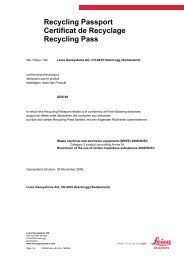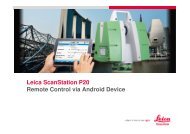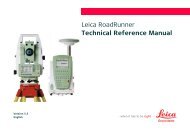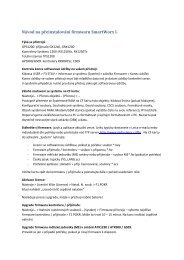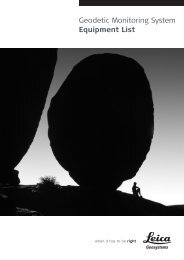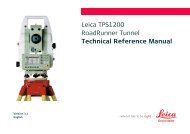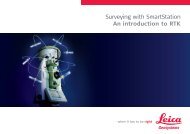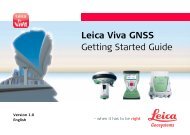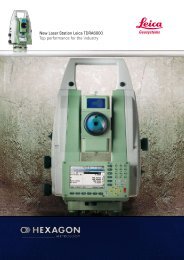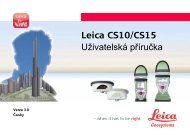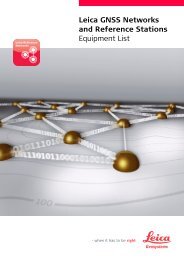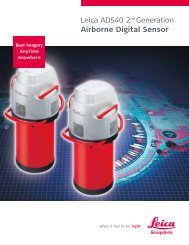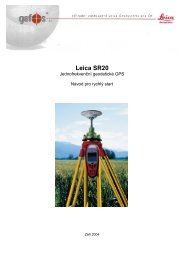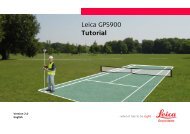Leica FCMS Flight & Sensor Control Management System - Gefos
Leica FCMS Flight & Sensor Control Management System - Gefos
Leica FCMS Flight & Sensor Control Management System - Gefos
You also want an ePaper? Increase the reach of your titles
YUMPU automatically turns print PDFs into web optimized ePapers that Google loves.
<strong>Leica</strong> <strong>FCMS</strong><br />
<strong>Flight</strong> & <strong>Sensor</strong> <strong>Control</strong><br />
<strong>Management</strong> <strong>System</strong><br />
Best control<br />
Anytime<br />
Any sensor
<strong>Leica</strong> <strong>FCMS</strong><br />
<strong>Flight</strong> & <strong>Sensor</strong> <strong>Control</strong><br />
<strong>Management</strong> <strong>System</strong><br />
Airborne survey flights have always been a challenge for pilots and sensor<br />
operators. The <strong>Leica</strong> <strong>Flight</strong> & <strong>Sensor</strong> <strong>Control</strong> <strong>Management</strong> <strong>System</strong> (<strong>FCMS</strong>)<br />
makes survey flights a convenient task. A sensor system is controlled and<br />
operated by <strong>FCMS</strong>. It performs all tasks, such as flight guidance, sensor<br />
release and sensor monitoring, on a single man-machine interface. Since<br />
the software provides automated operation, user interaction is minimized.<br />
Operation is intuitive and novice users are able to operate the sensor after<br />
a very short training time. Precise aircraft positioning is a simple task for the<br />
pilot due to the sophisticated flight guidance information provided during all<br />
phases of the survey flight. Additionally, in-flight quality control considerably<br />
increases productivity and cuts data acquisition cost.<br />
The <strong>Leica</strong> Geosystems’ solution<br />
consists of top-quality airborne<br />
components perfectly integrated<br />
into the sensor system. Careful<br />
attention is given to optimize<br />
the workflow starting with flight<br />
planning and ending with the<br />
deliverable data. <strong>FCMS</strong> tightly<br />
integrates flight and sensor<br />
control in the entire workflow.<br />
The OI40 is a high-resolution pressuresensitive<br />
LCD touch screen that operates<br />
the ADS40 Airborne Digital <strong>Sensor</strong>.<br />
Key benefits<br />
Higher productivity<br />
• Shorter and more efficient flights<br />
• Reduced stress on the flight crew<br />
Lower costs<br />
• Minimal repetition of survey flights<br />
• Lower aircraft maintenance cost<br />
• Faster return on investment<br />
FPES<br />
<strong>Flight</strong> planning<br />
<strong>Flight</strong> planning<br />
<strong>Flight</strong> plan optimization<br />
Project management<br />
Cost estimation<br />
<strong>Flight</strong> evaluation<br />
Check of completeness<br />
Quality control<br />
Project management<br />
Cost calculation<br />
Reference<br />
Measure<br />
Analyze<br />
Present<br />
<strong>FCMS</strong><br />
<strong>Flight</strong> execution<br />
Guidance information<br />
during approaches<br />
and turns<br />
Guidance information<br />
and sensor release<br />
along the line<br />
In-flight<br />
evaluation<br />
User<br />
log<br />
entries<br />
<strong>Sensor</strong><br />
<strong>Control</strong><br />
Data<br />
logging
The in-line view provides graphical information for the pilot to<br />
navigate along the line. <strong>Sensor</strong> and numeric navigation information<br />
is also displayed.<br />
The Nose-up view provides optimized graphical information for<br />
the pilot to approach a line. <strong>Sensor</strong> and numeric navigation<br />
information is also displayed.<br />
Ease of use makes the <strong>Leica</strong> <strong>Flight</strong> &<br />
<strong>Sensor</strong> <strong>Control</strong> <strong>Management</strong> <strong>System</strong><br />
(<strong>FCMS</strong>) an excellent investment<br />
<strong>FCMS</strong> is an easy to learn, fully integrated flight guidance<br />
module. Getting started is simple and fast due to the integrated<br />
on-line help and the simulator software to train pilots<br />
and operators on the ground. Quick navigation through<br />
the menu tree makes operation easier. The system is also<br />
fully configurable for different users. Highly automated<br />
software features automatic sensor release according to<br />
the flight plan. Completeness of the project for flight plan<br />
controlled photo flights is also monitored.<br />
Intuitive operation yields higher productivity<br />
<strong>FCMS</strong> operates the sensor as a single man-machine interface<br />
means all tasks, such as flight guidance, sensor release and<br />
sensor monitoring, are handled for the user. <strong>FCMS</strong> takes<br />
control of either a single or multi-sensor system.<br />
<strong>FCMS</strong> starts and stops image data recording or<br />
releases frame sensors at the planned positions. Additional<br />
recording sequences can be released manually at any<br />
time. Novices can operate the sensor system after very<br />
little training time. Because of the in-flight quality control,<br />
productivity increases and costs are trimmed. <strong>Flight</strong>s are<br />
shorter and more efficient, which puts less stress on the<br />
crew. With reduced repetition of survey flights and lower<br />
aircraft maintenance costs, the overall costs of projects<br />
are lower and productivity is higher.<br />
<strong>FCMS</strong> flight guidance and in-flight evaluation<br />
<strong>FCMS</strong> makes a flight plan controlled flight a simple task<br />
for the operator and pilot, guiding them through all<br />
phases of the survey flight. Knowing in-flight which lines<br />
are not yet flown and which lines need to be re-flown<br />
for various reasons, such as clouds, is important. During<br />
flight execution, the operator and the pilot can independently<br />
select various views. The optimized flight guidance
The North-up view provides a graphical presentation of the<br />
project, as well as sensor and navigation information. The example<br />
shows vector data as a backdrop<br />
<strong>FCMS</strong> monitors the progress of project execution for<br />
in-flight evaluation.<br />
offers north-up views for project overview and controlling<br />
the flight execution progress. The nose-up view is offered<br />
for optimized approach and turns with suggested flight<br />
path, and the in-line view is offered for precise navigation<br />
along the line. If a specific portion of a flight line is<br />
missed, <strong>FCMS</strong> will provide an exact guide to the missing<br />
part. In-flight evaluation allows flight execution progress<br />
and quality control checking. <strong>FCMS</strong> stores, in flight, all<br />
data required for post-flight mission analysis. This is<br />
essential for optimal management of aerial survey<br />
projects, especially for large projects with more than<br />
one aircraft used.<br />
High precision, GPS-supported navigation<br />
Navigation and graphical guidance information are displayed<br />
during all phases of the survey flight. This includes<br />
approach to the mission area, turns, and flight lines. Both<br />
sensor operator and pilot can compare the actual position<br />
with the desired position on their screens. The flight lines<br />
to be flown and the direction of approach can be freely<br />
selected. An optimal route-finder algorithm can automatically<br />
select the nearest flight line. The algorithm takes<br />
into account wind speed and wind direction.
The OC50 for the sensor operator is a<br />
rugged single-board computer with a high<br />
contrast LCD color screen and keyboard<br />
that operates the ALS50 Airborne Laser<br />
Scanner or other sensors.<br />
The OC50 for the pilot is a rugged singleboard<br />
computer with a high contrast LCD<br />
color screen designed for a cockpit<br />
environment.<br />
The GI40 provides guidance information to<br />
the pilot. It can be used in parallel with the<br />
OC50.<br />
Main features<br />
Outstanding performance<br />
• Supports various sensor types as well as multi-sensor<br />
systems<br />
• Reliable high-quality hardware conforming to ISO<br />
7137, RTCA DO-160E, EUROCAE-14E and FAR§23.561<br />
Simple and easy to learn operation of the sensor<br />
• Clear icons and quick navigation within the menu options<br />
• Simulator software to train operators and pilots on the<br />
ground<br />
Optimized flight guidance<br />
• Different displays of suggested flight path, approach<br />
and turns<br />
• Vector data and ground control points as a backdrop for<br />
flight guidance<br />
• Optimized guidance information for flight lines to be<br />
flown at constant altitude above mean sea level (AMSL)<br />
or at constant altitude above ground level (ALT-AGL)<br />
Highly automated<br />
• Automatic sensor release according to the flight plan<br />
• Monitors various parameters such as GPS quality, etc.<br />
• Monitors completeness of project for flight<br />
plan-controlled survey flights<br />
Remote control from multiple user interfaces<br />
• Operator and pilot can display different views<br />
In-flight evaluation for quality control<br />
• If part or all of a flight line has flawed data, it is<br />
accordingly marked<br />
• Previous flights can be taken into account<br />
Perfect data interfaces within the workflow<br />
• Streamlined data interface from flight planning to<br />
flight evaluation<br />
• User log entries during the flight is appended to the<br />
data
Whether you want to capture airborne data of an agricultural area or of<br />
a city, record the challenges in a disaster area or the expanse of a high<br />
tension line, you need reliable measurements and solutions for your<br />
entire workflow to build image-based maps. <strong>Leica</strong> Geosystems broad<br />
array of airborne sensors and integrated software solutions capture data<br />
efficiently, reference imagery accurately, measure easily, analyze and<br />
present spatial information in 3D.<br />
Those who use <strong>Leica</strong> Geosystems products every day trust them for<br />
their precision, their seamless integration and their superior customer<br />
support. When data really counts, <strong>Leica</strong> Geosystems delivers geospatial<br />
imaging solutions with precision, integration and service.<br />
When it has to be right.<br />
Illustrations, descriptions and technical specifications are not binding and may change.<br />
Printed in Switzerland – Copyright <strong>Leica</strong> Geosystems AG, Heerbrugg, Switzerland, 2007.<br />
758020en – X.07 – RDV<br />
Total Quality <strong>Management</strong> –<br />
our commitment to total<br />
customer satisfaction.<br />
Ask your local <strong>Leica</strong> Geosystems<br />
dealer for more information<br />
about our TQM program.<br />
<strong>Leica</strong> FPES<br />
Product brochure<br />
<strong>Leica</strong> ADS40<br />
Product brochure<br />
<strong>Leica</strong> ALS50-II<br />
Product brochure<br />
<strong>Leica</strong> IPAS10<br />
Product brochure<br />
<strong>Leica</strong> Geosystems AG<br />
Heerbrugg, Switzerland<br />
www.leica-geosystems.com



